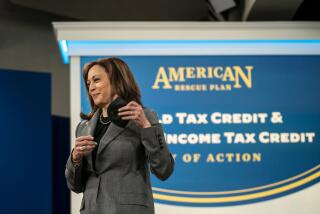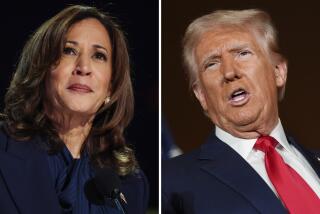Here’s confirmation the tax code’s a mess
Add yet another thing to President-elect Barack Obama’s to-do list: Tax reform.
If Timothy Geithner -- the guy Obama wants to run the Treasury Department -- could make $34,000 worth of mistakes on recent federal tax returns, then clearly this is a system so bloated and complex as to be incomprehensible to all but the most pointy-headed accountants.
“The system has gotten out of hand,” said Bob Carroll, vice president for economic policy at the Tax Foundation, a nonpartisan Washington think tank, and former deputy assistant Treasury secretary for tax analysis in the Bush administration.
“Year in and year out, Congress and whichever administration is in power adds more layers to the tax code. And it will keep getting worse.”
The labyrinthine nature of the tax code was Geithner’s excuse for depriving Uncle Sam of much-needed revenue. It was reported last week that Geithner failed to pay Social Security and Medicare taxes while working for the International Monetary Fund between 2001 and 2004.
He was technically considered self-employed while at the IMF and was required to pay the taxes himself, rather than have the funds withheld by his employer. Obama called the unpaid taxes “an innocent mistake.”
Aside from the entertainment value of our likely next Treasury secretary either being ignorant of tax rules or being a tax cheat, the episode highlights the lunacy of a tax code that now runs more than 60,000 pages. More than 500 changes were made last year alone.
The Internal Revenue Service’s national taxpayer advocate estimates that the complexity of the tax code results in taxpayers spending about $193 billion a year complying with filing requirements -- the equivalent of 14% of all income taxes collected.
About 60% of taxpayers feel it necessary to pay a professional to handle their taxes, and another 22% purchase tax-preparation software like TurboTax. In other words, more than 80% of Americans pay each year for help with their taxes.
“The system is broken,” said Gina DeRosa, a certified public accountant in Torrance. “Eighty percent of the country should not need help filing taxes.”
Most tax-reform mavens will say any remedy should include at least three key components: fairness, sustainability and simplicity.
Fairness means we want people with more money to pay more in taxes -- a progressive system like we have now.
Sustainability means that any changes will either maintain existing revenue levels or increase revenue.
As for simplicity, well, that speaks for itself. And it’s perhaps the most challenging goal of all.
The first simplification measure should be doing away with the alternative minimum tax, a levy intended for a relative handful of wealthy taxpayers but, because it’s not indexed for inflation, is projected to affect 50 million people by 2015.
The downside to tossing out the alternative minimum tax, however, is that this would blow a more than $1-trillion hole in the federal budget. Unless we want to go even deeper into debt than we are, that shortfall would have to be made up somewhere.
Some reformers are enamored of a one-size-fits-all flat tax. But a bipartisan tax-reform panel crunched the numbers in 2005 and found that a flat rate of at least 21% would be required to maintain existing revenue levels -- a tax increase for many people.
A flat tax also would be less progressive than our current system, the panel found. Low-income and middle-class filers would actually see their percentage of taxes paid go up, while the wealthiest Americans would see their percentage decline.
Proponents of a so-called fair tax say we should do away with income taxes and replace them with a federal sales tax of about 23%.
“The fair tax is simple, transparent and progressive,” said Ken Hoagland, a spokesman for FairTax.org, an advocacy group. “Every citizen pays taxes at the cash register as a consumer.”
One problem with that -- and it’s a big one -- is that state and local taxes would come on top of that national consumption tax. In Los Angeles, where Measure R has increased the sales tax to 8.75%, this would mean a total levy of more than 30% every time you buy something.
That $100 pair of shoes? Make it $130. That $10,000 used car? We’ll call it $13,000.
That’s a whole lot of sticker shock. Some economists say a consumption tax that hefty would almost certainly prompt some merchants not to collect or report the tax, and would also foster a black market of untaxed goods.
How about we keep the current system but radically simplify it by doing away with most exemptions, credits and deductions?
Carroll at the Tax Foundation said such a change would bring in more revenue and result in lower rates for most taxpayers. For example, people earning $70,000 a year would pay about 16% of their income to Uncle Sam rather than the current 25%.
That sounds swell. But the politics of an income tax overhaul would be real ugly. Which exemptions do we get rid of and which ones do we keep? How do we decide who wins and who loses?
My sense is that some sort of hybrid approach might be best. We could start with a national consumption tax in the 5% range. Then we could lower income-tax rates by eliminating most exemptions and deductions, but still keep some of the biggies, such as the deductions for mortgage interest and charitable giving.
It wouldn’t be a perfect system, but it’d be a lot easier for taxpayers to comprehend than what we have now.
“This would be possible with the right leadership,” Carroll said. “You have to have a president who is completely behind the effort, as well as key members of Congress.”
Or at the very least a Treasury secretary who knows how to pay his taxes.
--
David Lazarus’ column runs Wednesdays and Sundays. Send your tips or feedback to david.lazarus@latimes.com.
More to Read
Inside the business of entertainment
The Wide Shot brings you news, analysis and insights on everything from streaming wars to production — and what it all means for the future.
You may occasionally receive promotional content from the Los Angeles Times.











